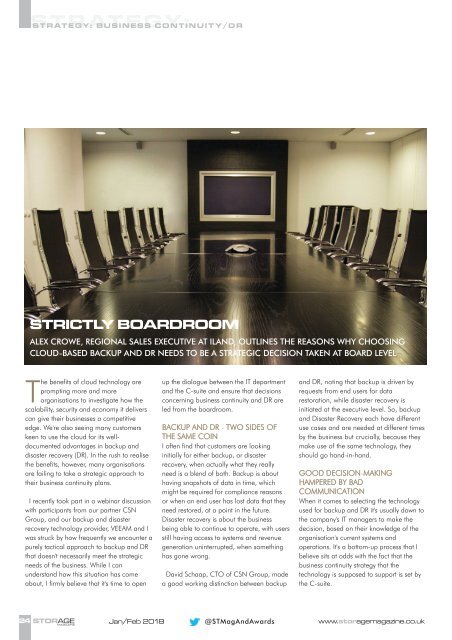ST1801
You also want an ePaper? Increase the reach of your titles
YUMPU automatically turns print PDFs into web optimized ePapers that Google loves.
STRATEGY:<br />
STRATEGY: BUSINESS CONTINUITY/DR<br />
STRICTLY BOARDROOM<br />
ALEX CROWE, REGIONAL SALES EXECUTIVE AT ILAND, OUTLINES THE REASONS WHY CHOOSING<br />
CLOUD-BASED BACKUP AND DR NEEDS TO BE A STRATEGIC DECISION TAKEN AT BOARD LEVEL<br />
The benefits of cloud technology are<br />
prompting more and more<br />
organisations to investigate how the<br />
scalability, security and economy it delivers<br />
can give their businesses a competitive<br />
edge. We're also seeing many customers<br />
keen to use the cloud for its welldocumented<br />
advantages in backup and<br />
disaster recovery (DR). In the rush to realise<br />
the benefits, however, many organisations<br />
are failing to take a strategic approach to<br />
their business continuity plans.<br />
I recently took part in a webinar discussion<br />
with participants from our partner CSN<br />
Group, and our backup and disaster<br />
recovery technology provider, VEEAM and I<br />
was struck by how frequently we encounter a<br />
purely tactical approach to backup and DR<br />
that doesn't necessarily meet the strategic<br />
needs of the business. While I can<br />
understand how this situation has come<br />
about, I firmly believe that it's time to open<br />
up the dialogue between the IT department<br />
and the C-suite and ensure that decisions<br />
concerning business continuity and DR are<br />
led from the boardroom.<br />
BACKUP AND DR - TWO SIDES OF<br />
THE SAME COIN<br />
I often find that customers are looking<br />
initially for either backup, or disaster<br />
recovery, when actually what they really<br />
need is a blend of both. Backup is about<br />
having snapshots of data in time, which<br />
might be required for compliance reasons<br />
or when an end user has lost data that they<br />
need restored, at a point in the future.<br />
Disaster recovery is about the business<br />
being able to continue to operate, with users<br />
still having access to systems and revenue<br />
generation uninterrupted, when something<br />
has gone wrong.<br />
David Schaap, CTO of CSN Group, made<br />
a good working distinction between backup<br />
and DR, noting that backup is driven by<br />
requests from end users for data<br />
restoration, while disaster recovery is<br />
initiated at the executive level. So, backup<br />
and Disaster Recovery each have different<br />
use cases and are needed at different times<br />
by the business but crucially, because they<br />
make use of the same technology, they<br />
should go hand-in-hand.<br />
GOOD DECISION-MAKING<br />
HAMPERED BY BAD<br />
COMMUNICATION<br />
When it comes to selecting the technology<br />
used for backup and DR it's usually down to<br />
the company's IT managers to make the<br />
decision, based on their knowledge of the<br />
organisation's current systems and<br />
operations. It's a bottom-up process that I<br />
believe sits at odds with the fact that the<br />
business continuity strategy that the<br />
technology is supposed to support is set by<br />
the C-suite.<br />
^<br />
24 STORAGE<br />
Jan/Feb 2018<br />
@STMagAndAwards<br />
www.storagemagazine.co.uk<br />
MAGAZINE

















